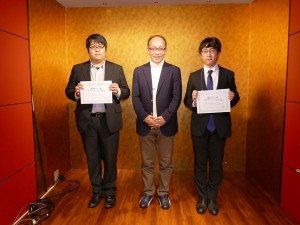2017年12月12日
【受賞/表彰等】酒井研究室 森勇稀さん(M1)が「第23回流動化・粒子プロセッシングシンポジウム」において優秀ポスター賞を受賞されました
【受賞/表彰等】酒井研究室 森勇稀さん(M1)が「第23回流動化・粒子プロセッシングシンポジウム」において優秀ポスター賞を受賞されました。
■受賞日
2017年12月7日
■氏名
森勇稀
■学部・研究科、学科(類・課程)・専攻等と学年
工学系研究科原子力国際専攻 修士課程1年
■受賞した賞の名称と簡単な説明
優秀ポスター賞
学会のポスター発表内で優秀な発表を行った学生に送られる賞です。
■受賞された研究・活動について
講演タイトル
大規模産業用流動層のためのEuler-Lagrange法の開発
講演概要
これまで、流動層の挙動把握のために実験による解析の他に数値解析が行われてきました。その数値解析の中で広く用いられる手法として、Euler-Lagrange的手法であるDEM-CFD法があります。しかしこの手法は計算できる系の大きさが粒子数に限られてしまうため、大規模な流動層に適用できないという問題がありました。また、産業用流動層では様々な形状の壁面を扱わなければならないので、任意形状壁面を効率的に解析する手法も必要とされていました。
そこで、本研究ではこれらを解決し、大規模な産業用流動層を解析するための手法を開発しました。この手法では粒子群を大きな粒子にまとめて計算することによって計算粒子数を大幅に削減し、計算の大規模化を可能にするDEM粗視化モデルを使用し、また、任意形状の壁面に対してメッシュ生成を行わず構造格子を用いて効率的に解析できるAdvanced DEM-CFD法も使用しています。しかし、これらを組み合わせて使用しても粒子が密である部分で流体抗力が発散し、計算が不可能となる場合がありました。そこで本研究で流体抗力項を陰的に解く手法を新たに開発し、安定した計算を行うことを可能にしました。
これらの手法を組み合わせた新しい数値解析手法により、斜面やパイプなどを持ち、粒子数が3250万粒子という大規模な流動層の数値解析を実際に行い、その結果を実験と比較することにより開発した数値解析手法の妥当性を確認しました。
■今後の抱負・感想
この度、このような賞をいただき大変光栄に思います。研究のご指導を賜りました酒井幹夫先生、ならびに研究室の皆様に深く感謝いたします。今後一層研究活動に勤しみ、研究内容を更に発展させていきたいと考えております。
■Name
Yuki Mori
■Faculty/Graduate School, Department (Stream / Program) / Major
MSc student, Department of Nuclear Engineering and Management, School of
Engineering
■Name of award and short explanation about the award
Best Poster Award
It was given for the superior presentation at poster session at this symposium.
■About awarded research
Numerical simulations of fluidized bed are often performed for analyzing this behavior. In numerical simulation, DEM-CFD method, one of the Eulerian-Lagrangian approach, is often used. Although this method is well established, it has a couple of problem, such as substantial limit of number of calculated particles, and difficulty of calculating gas-solid flow in arbitrary shaped-wall effectively. For these problems, numerical simulation of large-scale engineering fluidized bed was very difficult.
Then, to solve these problems, we developed new numerical simulation method. In this method, coarse grain model(CGM) is introduced. In this model, a group of particles are represented by a coarse grain particle, then this model enabled us to use enormous number of original particles. Besides, Advanced DEM-CFD method are also introduced for calculated boundary wall of solid and fluid phase. However, by using these methods, we couldn’t calculate large-scale engineering fluidized bed, because drag force term are very big in dense place, and tend to divergence calculation. Thus, we developed new implicit method for drag force term. It enables us to execute numerical simulation stably.
Finally, in order to validate developed method, we performed numerical simulation and experiment of fluidized bed under comparable conditions.
■Your impression & future plan
It is my great honor to win this award. I really thank Prof. Mikio Sakai for his excellent supervision, and I also thank all members of my laboratory. I will keep researching hard and try to improve our researches.



